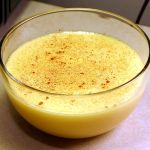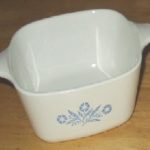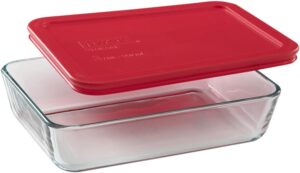By Cat, Aug 2007 (Photo, right, from Wikimedia Commons)
My favorite dessert! And healthful, too. My Mom used to make this frequently when I was little, and then in high school she taught me how to make it. Sometimes we would bake it in a pyrex baking pan (square or rectangular); other times we’d bake it in individual pyrex custard cups. As an adult, I sometimes add fruit, such as frozen berries or slices from a ripe pear.
Mom always used sugar to sweeten the custard, and I did too for many years. But now I avoid sugar and have learned how to sweeten with stevia extract. I provide instructions for either minimally-processed sugar or stevia, or you could use a portion of each; another option is xylitol (use the same amount as given for sugar). I do not recommend using Splenda (sucralose) or other artificial sweeteners.
Custard can be baked in the oven (using a water bath around the custard cups or baking dish/casserole), or on top of the stove (using a double boiler or heavy-bottomed saucepan; see Crème Anglaise (Stove-Top Custard Sauce for instructions). Stove-top custard is the basis for most milk-based puddings, and cream pies.
- Includes: 1. Creamy Egg Custard; 2. Variation: Extra-Rich & Low Carb, Creamy Egg Custard;
- See also: 1. Pudding & Frozen Dessert Recipe Menu; 2. Crème Anglaise (Stove-Top Custard Sauce
About the ingredients
It’s important to use whole milk or added cream, because the butterfat helps your body assimilate the minerals from the milk and eggs. If you use all coconut milk, it may not have the right texture – you may need to add a bit of flour or starch, but a mix of half coconut milk and half whole milk works well and gives it a light coconutty flavor. Light coconut milk is not recommended, as it is too watery and the custard will not set.
I’ve not tried other nut milks, such as almond milk, but I think it would be similar to coconut milk and require half nut milk and half whole milk (from cow or goat).
While soy milk will work, I advise avoiding soy products unless they are fermented (refer to my articles on the problems of soy). If you must use soy, make your own, or use commercial plain soy milk (made from just soybeans and water), or vanilla-flavored (and omit the added vanilla).
If you use stevia extract powder, dissolve it in the vanilla before mixing into the custard. OR dissolve it in 2 – 3 tsp orange/lemon juice or other fruit juice, before mixing into the custard. This ensures it is evenly distributed throughout the custard; using fruit juice also minimizes any bitter aftertaste in the stevia.
Creamy Baked Custard
This is based on my Mom’s recipe. Bake this in a single casserole dish, or in individual custard cups; either way, set the baking dish(s) in a water bath for even heating, and to avoid overheating (and denaturing) the proteins in the egg and milk.
Mom always made custard without added fruit, as she preferred to sprinkle the top with ground nutmeg. But I like including a bit of berries in my custard. When adding fruit, it tends to float and re-distribute; if you want to keep the same amount of fruit per serving, use individual custard cups.
I originally sized this recipe for a 4 – 6 cup Corningware baking pan (see photo, right, from Wikimedia Commons), but lately I’ve been using i my 5″ x 7″ rectangular Pyrex baking pan with storage lid (photo, below, from Amazon (_)
Serves 6.
Ingredients & Equipment
- 3 large fresh farm eggs
- ½ – 1 teaspoon natural vanilla extract
- scant ¼ tsp powdered stevia extract (dissolved in vanilla extract), OR ¼ cup Rapadura sugar, white cane sugar, or xylitol
- 2 cups whole milk (preferably raw), or mix of milk and cream
- pinch of Unrefined sea salt
- ground nutmeg (optional)
- Equipment
- 4 cup glass measuring cup, or bowl with a pouring lip
- baking container options:
- 6 glass or porcelain custard cups; or
- a single 4-to 6-cup baking dish [I use my tall, square Corning Ware casserole pan with storage lid; or
- a 5″ x 7″ (3-cup) rectangular Pyrex baking pan with storage lid (see photo from Amazon, below)
- cake pan to hold custard cups or baking dish in ½ inch of water
- cooling rack
* NOTE: For a richer custard, use a mixture of whole milk and cream; for example, my Extra-Rich variation below. Another option is to use 1 cup coconut milk (not the ‘light’ version) and 1 cup whole milk.
Preparation
- Preheat oven to 325°F. Butter custard cups or baking dish.
- If using stevia, dissolve it in the vanilla (or fruit juice) in a small bowl, then add milk/cream.
- Beat eggs in a bowl (preferably with a spout) with a wire whip until well blended & slightly fluffy. Add sugar/xylitol if using, and beat again.
- Add milk/cream mix and salt, and beat again until well mixed. If you used sugar or xylitol, it will tend to settle in the bowl.
- Pour custard into buttered custard cups or baking dish. Set cups or baking dish in the pan of water (water should come halfway up the side of the cups/baking dish), sprinkle tops with ground nutmeg (optional), and place pan in oven.
- Bake: custard cups about 30-35 minutes, or baking dish about 45 minutes. Custards are done when a knife inserted into center of the custard comes out clean.
- Remove pan from oven, and place cups/baking pan on a cooling rack to cool a bit, then move to the refrigerator until ready to serve.
Extra-Rich & Low Carb, Creamy Egg Custard
I’m currently following a ketogenic eating plan (to reset my metabolism). This is a type of low-carb eating plan, but higher in fat and lower in carbs than the Adkins diet. I make this custard for a lunch-time treat, using stevia as the sweetener (no sugar), and a mix of whole milk and heavy cream instead of just whole milk. This combo totals 173 calories with 0.5 grams carbs, 5.5 grams protein, and 16 grams fat per 1-cup serving. (Note, I count only 10% of listed carbs in milk and cream as true carbs, because the other 90% are converted to lactic acid by your gut bacteria, rather than being absorbed as sugar).
The ingredients are listed below; the equipment and preparation method are the same as the above recipe. This version includes added fruit but you can skip that if you want just a plain custard. I use my 5.5″ x 7.5″ Pyrex baking pan; it has a red plastic lid to cover it after cooling, for storage in the refrigerator.
If adding fruit, it tends to float and re-distribute; if you want to keep the same amount of fruit per serving, use individual custard cups.
Ingredients:
- 3 extra-large fresh farm eggs
- ½ tsp natural vanilla extract
- scant ¼ tsp powdered stevia extract dissolved in vanilla (or in ¼- ½ tsp fruit juice)
- 2 cups whole milk/heavy cream mixture (I use 1 ¼ cups milk and 3/4 cup cream, or 1 cup each, milk and cream))
- pinch of Unrefined sea salt
- sliced almonds (optional)
- ground nutmeg (optional)
- frozen berries or other fruit, chopped (optional)
- Equipment same as first recipe
Preparation
- Preheat oven to 325°F. Butter custard cups or baking dish.
- Dissolve stevia in vanilla (or fruit juice).
- Beat eggs in a bowl with a wire whip until well blended & slightly fluffy. NOTE: if you use a blender, the mixture will have greater volume than when you use a whip, so you may need an extra custard cup or larger baking dish.
- Add milk/cream mixture, vanilla and dissolved stevia, salt, and beat again until well mixed.
- Pour custard into the custard cups or baking dish. Set cups/dish in pan of water (water should come halfway up the side of the baking container), sprinkle tops with any/all of the following optional ingredients: sliced almonds, ground nutmeg, chopped, and/or frozen berries; place pan in oven. Cat’s note: sliced almonds and ground nutmeg are my favs.
- Bake: custard cups about 30-35 minutes, or baking dish about 45 minutes. Custards are done when a knife inserted into center of the custard comes out clean.
- Remove pan from oven, and place cups/baking pan on a cooling rack to cool a bit, then move to the refrigerator until ready to serve.
Testing
Mar 13, 2020: Made rich version as written, using ½ cup cream and 1½ cup whole milk, 3 eggs, ¼ tsp stevia extract powder mixed with 1 tsp vanilla extract, pinch salt, and with nutmeg sprinkled over the top. Use my Corning Ware casserole dish set into a glass pan with water half-was up casserole dish. Into 325°F oven at 6:40 PM. Tested at 6:550; not yet; 7:05; done and out of oven at 7:10 PM; total 45 min. Result: Served with thawed, frozen blueberries and raspberries from my garden, some pecans, and topped with heavy cream. Delicious!
July 11, 2020: Made rich version as written, but the eggs were small, so didn’t make as much custard. Still delicious as ever; I serve with chopped frozen berries that are thawed, and lots of fresh cream. Mmm.
Serving Options (either recipe)
- Serve in custard cup, as is, and topped with cream or whipped cream;
- Slide a knife around the inside edge of the cup to loosen the custard, then turn out onto a dessert plate or bowl. Garnish with fresh raspberries, blueberries or sliced strawberries or peaches and a dollop of whipped cream.
- If you used a single baking dish for the custard, cut into squares/rectangles or spoon out into small bowls to serve, with cream, whipped cream and/or fresh berries or other fruit.



